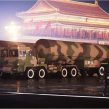
PRC’s National Day to Showcase China’s Rise
Publication: China Brief Volume: 9 Issue: 18
By:

The Hu Jintao administration appears to be pulling out all the stops for the October 1 celebration of the 60th anniversary of the founding of the People’s Republic of China (PRC). The country’s National Day will be inaugurated by a keynote speech by Paramount Leader Hu. The occasion of the speech has been used by his predecessors, Deng Xiaoping and Jiang Zemin, as a capstone on the state of China’s path toward modernization, which was spearheaded by Deng’s "opening-up" reforms in the 1970s. The ceremony will be crowned by a gargantuan military review through Tiananmen Square that is slated to showcase the coming of age for China’s second-generation military hardware and technologies and to demonstrate the Chinese military’s designing and manufacturing prowess. The October 1 parade will be the 14th military parade since 1949.
Rehearsals for the epic military review are already underway and not a shred of doubt about security in the central and neighboring administrative regions is being taken lightly as the authorities tackle growing unrest in its peripheral regions. Chen Jiping, deputy director of the Central Committee for Comprehensive Management of Public Security—which coordinates the activities of the police, state security agents and judicial departments—announced on September 6 that seven municipalities, provinces and an autonomous region (i.e. Beijing, Tianjin, Hebei, Shanxi, Shandong, Liaoning and Inner Mongolia Autonomous Region) have signed an agreement that will establish a security "moat," or comprehensive security checks, to "fence off the potential threats" (Xinhua News Agency, September 6).
While Chinese experts remain tight-lipped about the specific missile models that will be on display, outside experts have been able to gleam the fact from photos of the September 6 rehearsal, which analysts say exhibit an unprecedented show of strength. According to a Chinese state-media report, there will be five types of missiles, including nuclear intercontinental ballistic missiles (ICBMs), conventional cruise missiles and medium-range and short-range conventional missiles on display that have never been officially reported before (Xinhua News Agency, September 2). Andrei Chang (aka Andrei Pinkov), editor-in-chief of Kanwa Defense Review Monthly, pointed out that during the 1999 military parade, the PLA only displayed three Dong Feng-31 (East Wind-31) ICBMs, while this year that number leaped to eight. The DF-31 (CSS 10 Mod 1) and its longer-range variant DF-31A (CSS 10 Mod 2) are road-mobile, solid-fuel ICBMs developed by the Academy of Rocket Motor Technology that have a maximum range of over 4,500 and 7,000 miles respectively. According to a recent U.S. government estimate, China has fewer than 15 launchers for each model (U.S. Air Force Air and Space Intelligence Center, Ballistic and Cruise Missile Threats 2009). "This is a sign they are sending to Washington that they have a counterstrike capability," said Chang (United Daily News [Taiwan], September 7; Defense News, September 8).
According to an anonymous source cited by the official Xinhua News Agency, who was only referred to as an expert from the Second Artillery Corps (SAC), China’s strategic missile forces: “Our [China’s] second generation [missiles] can match their [Russian and U.S.] third and fourth generations, and the third generation under development [e.g. DF-41] is comparable to their fifth and sixth generations” (Xinhua News Agency, September 9).
In recent years, the Chinese government has come under increasing pressure from the international community for the lack of transparency in its growing defense spending, which has experienced annual double-digit percentage increases that extend back for more than a decade. According to Chinese-official figures, China’s 2009 defense budget of $70.2 billion reflects an increase of 14.9 percent over 2008, and follows a rise of 17.6 percent in 2008 compared with the previous year (China Daily, March 4). U.S. sources put China’s actual defense budget closer to between $97 billion to $139 billion.
According to PLA Major General Luo Yuan, senior researcher and former deputy director of World Military Studies at the Beijing-based Academy of Military Sciences and member of the Chinese People’s Political Consultative Conference (CPPCC), a military review can serve four purposes:
First, a military review can provide an account of the country’s military spending to the Party and people. Since Western countries are increasingly calling for more transparency in Chinese military spending, according to Luo, greater transparency is needed not only toward the international community, but rather toward the Chinese people to demonstrate how the taxpayers’ money is being spent. The Chinese people have the ‘right to know’ how the military is revolutionizing, modernizing and regularizing.
Second, a military review is a form of promoting national defense awareness, and according to Luo, a strong nation must have a military spirit, a positive and firm attitude, and thus, having troops march in formation in front of the people can have the effect of raising national pride.
Third, for the People’s Liberation Army (PLA), a military parade can instill the feeling of honor and responsibility in the troops, and thereby boost morale.
Fourth, according to the major general, a military review can intimidate hostile countries. It can showcase China’s power and national power, and exhibit the formidable achievements that its defense sector has made in the past decade, and nurture patriotism (Ta Kung Pao [Hong Kong], September 8).





